Biosynthesis and degradation of H2O2 by vaginal lactobacilli
- PMID: 19948869
- PMCID: PMC2805228
- DOI: 10.1128/AEM.01631-09
Biosynthesis and degradation of H2O2 by vaginal lactobacilli
Abstract
Hydrogen peroxide production by vaginal lactobacilli represents one of the most important defense mechanisms against vaginal colonization by undesirable microorganisms. To quantify the ability of a collection of 45 vaginal Lactobacillus strains to generate H(2)O(2), we first compared three published colorimetric methods. It was found that the use of DA-64 as a substrate rendered the highest sensitivity, while tetramethyl-benzidine (TMB) maintained its linearity from nanomolar to millimolar H(2)O(2) concentrations. Generation of H(2)O(2) was found to be especially common and strong for L. jensenii strains, while it was variable among L. crispatus and L. gasseri strains. Biosynthesis of H(2)O(2) only occurred upon agitation of the cultures, but the H(2)O(2)-producing machinery was already present in them before aeration started. Calcium, magnesium, manganese, and zinc ions did not affect H(2)O(2) production, while Cu(2+) inhibited the growth of Lactobacillus jensenii CECT 4306, which was chosen as a model strain. Cultures with Fe(3+), hemin, and hemoglobin did not accumulate H(2)O(2). Fe(3+) activated an extracellular peroxidase that destroyed the H(2)O(2) being produced by the cultures. This protected the lactobacilli against its antimicrobial effect. The production of the enzyme appears to be constitutive, the Fe(3+) ions being a necessary cofactor of the reaction.
Figures
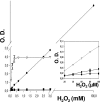
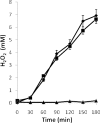
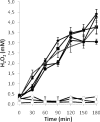

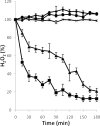
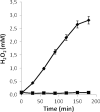
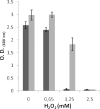
Similar articles
-
Detection of hydrogen peroxide-producing Lactobacillus species in the vagina: a comparison of culture and quantitative PCR among HIV-1 seropositive women.BMC Infect Dis. 2012 Aug 13;12:188. doi: 10.1186/1471-2334-12-188. BMC Infect Dis. 2012. PMID: 22889380 Free PMC article.
-
Inhibition of Staphylococcus aureus by H2O2-producing Lactobacillus gasseri isolated from the vaginal tract of cattle.Anim Reprod Sci. 2006 Nov;96(1-2):35-46. doi: 10.1016/j.anireprosci.2005.11.004. Epub 2005 Dec 28. Anim Reprod Sci. 2006. PMID: 16386389
-
Identification and H(2)O(2) production of vaginal lactobacilli from pregnant women at high risk of preterm birth and relation with outcome.J Clin Microbiol. 2004 Feb;42(2):713-7. doi: 10.1128/JCM.42.2.713-717.2004. J Clin Microbiol. 2004. PMID: 14766841 Free PMC article.
-
[Vaginal microbiota: composition, protective role, associated pathologies, and therapeutic perspectives].Enferm Infecc Microbiol Clin. 2008 Mar;26(3):160-7. doi: 10.1157/13116753. Enferm Infecc Microbiol Clin. 2008. PMID: 18358215 Review. Spanish.
-
The human vaginal microbial community.Res Microbiol. 2017 Nov-Dec;168(9-10):811-825. doi: 10.1016/j.resmic.2017.08.001. Epub 2017 Aug 26. Res Microbiol. 2017. PMID: 28851670 Review.
Cited by
-
Purification and genetic characterization of gassericin E, a novel co-culture inducible bacteriocin from Lactobacillus gasseri EV1461 isolated from the vagina of a healthy woman.BMC Microbiol. 2016 Mar 12;16:37. doi: 10.1186/s12866-016-0663-1. BMC Microbiol. 2016. PMID: 26969428 Free PMC article.
-
Secretome of Intestinal Bacilli: A Natural Guard against Pathologies.Front Microbiol. 2017 Sep 1;8:1666. doi: 10.3389/fmicb.2017.01666. eCollection 2017. Front Microbiol. 2017. PMID: 28919884 Free PMC article. Review.
-
Molecular mechanisms of the disturbance caused by malondialdehyde on probiotic Lactobacillus reuteri PL503.Microb Biotechnol. 2022 Feb;15(2):668-682. doi: 10.1111/1751-7915.13723. Epub 2020 Dec 23. Microb Biotechnol. 2022. PMID: 33356002 Free PMC article.
-
Behavioral predictors of colonization with Lactobacillus crispatus or Lactobacillus jensenii after treatment for bacterial vaginosis: a cohort study.Infect Dis Obstet Gynecol. 2012;2012:706540. doi: 10.1155/2012/706540. Epub 2012 May 30. Infect Dis Obstet Gynecol. 2012. PMID: 22693410 Free PMC article.
-
In Vitro assessment of anti-Campylobacter activity of lactobacillus strains isolated from canine rectal swabs.BMC Vet Res. 2022 Mar 22;18(1):112. doi: 10.1186/s12917-022-03204-9. BMC Vet Res. 2022. PMID: 35317800 Free PMC article.
References
-
- Álvarez-Olmos, M. I., M. M. Barousse, L. Rajan, B. J. Van Der Pol, D. Fortenberry, D. Orr, and P. L. Fidel. 2004. Vaginal lactobacilli in adolescents: presence and relationship to local and systemic immunity, and to bacterial vaginosis. Sex. Transm. Dis. 31:393-400. - PubMed
-
- Antonio, M. A., L. K. Rabe, and S. L. Hillier. 2005. Colonization of the rectum by Lactobacillus species and decreased risk of bacterial vaginosis. J. Infect. Dis. 192:394-398. - PubMed
-
- Boskey, E. R., R. A. Cone, K. J. Whaley, and T. R. Moench. 2001. Origins of vaginal acidity: high D/L lactate ratio is consistent with bacteria being the primary source. Hum. Reprod. 16:1809-1813. - PubMed
Publication types
MeSH terms
Substances
LinkOut - more resources
Full Text Sources
Other Literature Sources
Molecular Biology Databases

